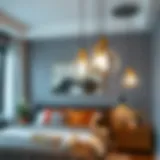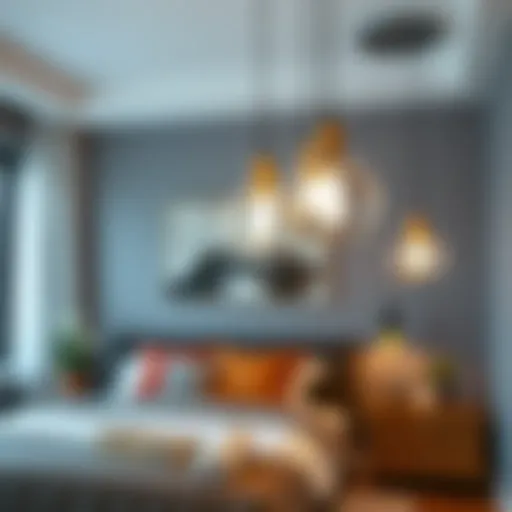The Definitive Guide to Choosing Indoor Blinds
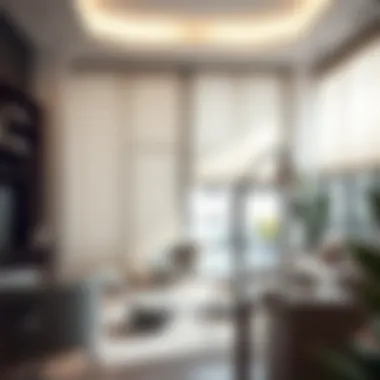
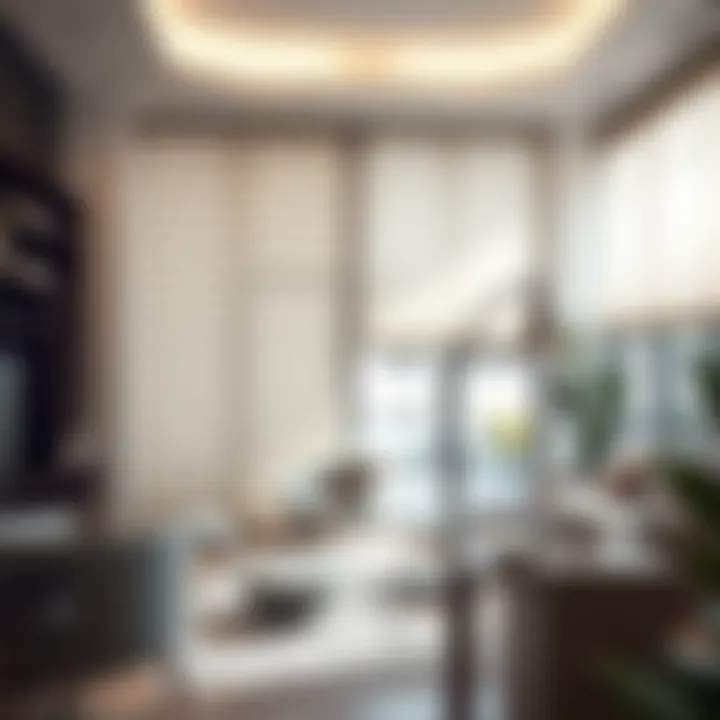
Intro
Choosing the right indoor blinds can feel like a daunting task. With a myriad of options at your fingertips, it’s easy to feel overwhelmed. This guide aims to cut through the noise, providing clarity on the types of blinds available, their materials, styles, and what practical considerations you should keep in mind to make an informed choice.
Indoor blinds serve more than just a decorative purpose; they control light, offer privacy, and can even enhance energy efficiency in your home. Whether you're sprucing up your living room, adding that missing touch in your office, or chasing the ambition of a total redesign, understanding the core elements of indoor blinds is key. Let’s navigate through current trends and practical tips to set you on the right path.
Furniture Design Trends
In the realm of interior design, trends come and go like the wind. However, some elements remain timeless and can complement any living space.
Current Styles and Themes
When it comes to styles, the world of indoor blinds has never been more diverse. From the minimalist appeal of sheer shades to the rustic charm of wooden blinds, each style serves a unique purpose. Blinds can range from traditional to contemporary and can be categorized into various styles such as:
- Roller Blinds: Sleek and functional, available in various colors and patterns.
- Vertical Blinds: Often seen in offices but can be stylishly incorporated into homes too.
- Roman Shades: These give a touch of elegance and are great for rooms where aesthetics are paramount.
- Cellular Shades: Designed for energy efficiency, they trap air and reduce heat loss.
Each style can complement specific themes in design—be it modern, bohemian, or industrial—helping you create the space you envision.
Color Palettes and Materials
Color palettes can drastically alter the mood of a room. Opt for light shades to create a soft, airy feel or deep hues for drama.
Additionally, the choice of material plays a crucial role:
- Fabric: Soft textures bring warmth, ideal for living rooms and bedrooms.
- Wood: Offers a natural look and durability but requires specific care.
- Vinyl: Provides practicality and ease of maintenance, particularly in kitchens and bathrooms.
- Aluminum: Perfect for modern designs, especially in urban settings.
Mindful selection of colors and materials will ensure the indoor blinds not only serve their purpose but also elevate the overall aesthetic of your space.
Practical Furniture Tips
With trends set, let’s pivot to practicalities. Beyond mere appearance, functionality is key when selecting blinds for your home.
How to Choose the Right Size
Nothing looks worse than ill-fitting blinds. Ensure accurate measurements; they should cover the window entirely for effective light control. Here’s a quick tip:
- Measure from the top of the window frame to the desired length. If the blinds are for privacy, you may want to add a few inches for overlap.
- Width matters as well—common sizes often give a snug fit while custom options cater to unique dimensions.
Maintenance and Care for Longevity
Once you’ve chosen the perfect blinds, maintaining them helps ensure they age well. Here are some straightforward tips to keep them looking fresh:
- Dust Regularly: A simple feather duster can prevent buildup.
- Spot Clean Stains: Use a damp cloth for fabric blinds and mild cleaners for vinyl and aluminum.
- Avoid Harsh Chemicals: These can damage materials and cause fading.
By following these steps, your indoor blinds won’t just be functional; they'll also stand the test of time, adding value to your living spaces.
"The right blinds can transform your home, merging style with practicality. Choose wisely!"
Understanding Indoor Blinds
Indoor blinds are often overlooked when it comes to home decor, but they are vital in establishing a comfortable and functional space. Selecting the right blinds goes beyond merely aesthetics; it's about enhancing your living environment to meet practical needs and personal preferences. This guide aims to shed light on various elements that define indoor blinds, their benefits, and why they deserve careful consideration in any interior planning.
Definition and Purpose of Indoor Blinds
Indoor blinds refer to window coverings that are installed inside a building, primarily to control light, enhance privacy, and add decorative flair to a room. They come in various styles, designs, and materials, from vertical slats that glide alongside windows to sleek roller blinds that retract effortlessly. The primary purpose of indoor blinds extends beyond simply blocking sunlight; they also act as an insulation barrier, improving energy efficiency within homes. Homeowners often find that having blinds installed can transform a room's ambiance, providing flexibility for changing daylight conditions throughout the day.
Benefits of Using Indoor Blinds
When exploring the benefits of indoor blinds, there are several key aspects that stand out. Understanding these can significantly influence the decision you make.
Light Control
One of the most crucial aspects of indoor blinds is light control. Different types of blinds offer varying degrees of light filtration. For instance, sheer blinds allow soft light to enter a room while providing some level of visibility, while blackout options completely block sunlight, making them ideal for bedrooms or media rooms. The ability to regulate light not only impacts mood and productivity but also protects furniture from sun damage.
"Effective light control can lead to improved health and wellbeing in your home."
Privacy
Privacy is another major reason homeowners opt for indoor blinds. In areas where houses are closely positioned, having the right blinds can make a world of difference. Some styles provide total coverage while still allowing natural light in, achieving the delicate balance between openness and seclusion. This characteristic makes them a popular choice for living areas and bathrooms, where the need for privacy often trumps the desire for an unobstructed view.
Energy Efficiency
Another undeniable advantage is energy efficiency. Indoor blinds can help regulate indoor temperatures by trapping heat in during colder months and reflecting it away during the warmer months. Specifically, cellular shades are designed with insulating properties that significantly reduce energy costs. This is not just good for your wallet but also benefits the environment, catering to the growing trend of eco-friendly living.
Decorative Elements
Finally, the decorative aspect of indoor blinds should not be overlooked. They come in a vast array of colors, textures, and designs, allowing homeowners to express their style while integrating with their overall decor. From classic wooden slats to vibrant fabric options, selecting the right blinds can enhance the aesthetics of a room, fulfilling both functional and artistic needs.
Incorporating carefully chosen blinds can truly elevate a space, making them not only protective gear against the sun but also a centerpiece that ties the whole room together.
Types of Indoor Blinds
When it comes to selecting the right indoor blinds for your home, understanding the various types available is crucial. This section dives into the unique categories of indoor blinds, highlighting their specific attributes, benefits, and key considerations. Choosing the appropriate type can significantly influence not just the aesthetics of your space, but also the functionality and comfort of your home.
Vertical Blinds
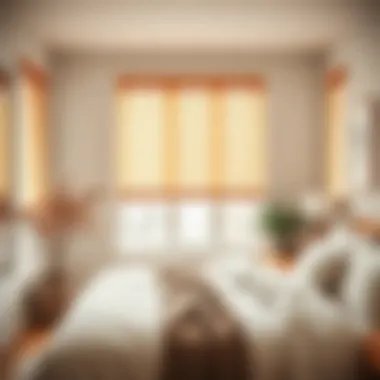

Vertical blinds are characterized by their long slats that hang vertically from a headrail. They can be adjusted to control light and privacy effectively. Their design makes them a popular choice for large windows or glass sliding doors.
- Advantages: Vertical blinds are excellent for light control because you can tilt the slats to allow light in or close them for darkness. They also provide a clean, modern look and can be made of various materials, including fabric, vinyl, and wood.
- Disadvantages: One downside to vertical blinds is that they can collect dust and be somewhat tricky to clean if they are made from fabric. Additionally, maintenance may be more demanding than other options on the market.
Horizontal Blinds
Horizontal blinds, often made of wood or aluminum, are classic window treatments. They consist of horizontal slats that can be tilted to achieve your desired atmosphere.
- Versatility: These blinds suit a variety of spaces, from living rooms to offices. They're particularly favored for their timeless appearance and ability to complement numerous design styles.
- Light Management: Horizontal blinds allow users to control light efficiently, although they may not block out light completely if gaps are present.
Roller Blinds
Roller blinds consist of a single piece of fabric that rolls up and down using a simple mechanism. They come in a wide range of colors and patterns, suitable for different rooms in the house.
- Functional: Roller blinds can provide varying levels of light filtration, making them a smart choice for numerous settings, like bedrooms or living rooms.
- Compact Design: Their minimalistic design helps in maximizing the view outside when fully rolled up, which is perfect for those who adore natural light.
Roman Blinds
Roman blinds offer a more elegant finish. They consist of fabric that folds up neatly when raised. The soft folds of fabric create a beautiful backdrop when the blinds are raised or lowered.
- Aesthetic Appeal: These blinds contribute a touch of softness and sophistication, blending beautifully with various decor styles from traditional to contemporary.
- Fabric Choices: The variety of fabric and pattern options means they can be tailored to reflect personal style.
Cellular Shades
Cellular shades, also known as honeycomb shades, are designed to trap air within their cells, providing excellent insulation.
- Energy Efficiency: They are particularly beneficial in both winter and summer, helping to maintain comfortable indoor temperatures without excessive energy use. This aspect can significantly lower heating and cooling costs.
- Sound Absorption: Their structure also helps in reducing sound transmission, making them a good choice for urban living.
Wooden Blinds
Wooden blinds bring a natural element into a space. They provide warmth and character, allowing for a sense of coziness in a room.
- Durability: Real wood options are often long-lasting and can withstand being opened and closed repeatedly. However, they do require proper care to prevent warping or fading.
- Style Compatibility: They tend to complement rustic or classic decor, enhancing the overall look of the room.
Sheer Blinds
Sheer blinds offer a unique blend of light control and privacy. The sheer fabric allows light to filter through while providing a level of obscurity from outside views.
- Subtle Elegance: They are an excellent choice for creating a soft and airy ambiance.
- Layering: Sheer blinds can work well with other window treatments, such as curtains or drapes, allowing for versatile styling options.
In summary, selecting the right type of indoor blinds involves understanding the functional benefits and design aesthetics each option offers. The right choice not only enhances the room’s look but also improves your living experience.
Material Considerations
When choosing indoor blinds, the material used can play a pivotal role in defining not just the aesthetic of a space, but also its functionality. It’s more than just a matter of personal taste; the right materials can enhance durability, energy efficiency, and maintenance ease. Homeowners and decorators alike need to consider how the materials used in blinds impact overall performance and usability. With a vast array of options available, this section will break down key factors to consider, making clear why material matters in the selection process.
Fabric Choices for Blinds
Fabric blinds offer a myriad of choices that can drastically alter the look and feel of a room. From sheer to thick, textured to smooth, the choices are as vast as the colors on a painter's palette. The type of fabric affects everything from light filtration to insulation. Here are some popular fabric options:
- Polyester: Known for its durability and easy maintenance, polyester is a common choice. It resists fading and is less prone to wrinkling, making it ideal for households with kids or pets.
- Cotton Blends: These provide a natural feel with better resilience than pure cotton. They offer a softer look but might require more attention in terms of care.
- Linen: Linen has a rich texture that adds an elegant touch, although it can be a bit pricier and tends to wrinkle more easily.
It's also worth noting that fabric can influence sound absorption properties. A heavier fabric may help reduce noise, making a significant difference if you live in a bustling neighborhood.
Wood vs. Faux Wood Blinds
The great debate of wood versus faux wood blinds often comes down to personal preferences and practical considerations. Real wood blinds exude warmth and sophistication, making them a popular choice for more traditional or upscale settings. Their natural variations add character, ensuring that no two pieces are exactly alike. However, genuine wood can be susceptible to warping in humid environments, limiting their versatility in certain areas of the home, like kitchens or bathrooms.
On the flip side, faux wood blinds mimic the look of real wood but offer better resistance to moisture and temperature changes. Crafted from composite wood materials and PVC, they are often more affordable than their wooden counterparts. They are easy to clean and maintain, making them an excellent option for those who want style without extensive care.
Synthetic Materials in Blinds
Synthetic materials, such as vinyl and PVC, have carved a niche in the world of indoor blinds due to their practicality and accessibility. Both materials are highly resistant to moisture and are less likely to warp or fade over time, making them ideal for high-traffic areas. Here’s a closer look:
- Vinyl Blinds: Known for their flexibility and cost-effectiveness, vinyl blinds are easy to clean and come in various colors and styles. They are great for those on a budget or anyone looking for hassle-free maintenance.
- PVC Blinds: A step up from basic vinyl, PVC offers added durability and a more sophisticated look. They can often simulate the appearance of wood while providing the toughness of synthetic materials.
In sum, each type of material presents its own benefits and challenges. Homeowners should weigh these against their specific needs—in terms of style, environment, and maintenance—when making a choice that will ultimately shape their interiors. For more insights on materials, exploring resources such as Britannica or Wikipedia can offer additional context.
Design and Style Options
Choosing indoor blinds isn't just a practical decision; it's also a design statement. The way they complement your home's aesthetic can elevate the ambiance and functionality of your space. That's where design and style options come into play. They give personality to a room, acting as a subtle yet effective way to express your taste and preferences while ensuring that your living area is inviting and comfortable. Selecting the right style optionality can contribute significantly to the overall atmosphere of your home, with considerations ranging from color choices to patterns, and how they mesh with existing decor.
Popular Color Palettes
When it comes to indoor blinds, colors matter a lot. They can either pop out or blend in, depending on your vision for the room. Popular choices for color palettes in indoor blinds often revolve around muted tones or stylish neutrals. Shades like beige, gray, and white are common because they evoke a sense of calm and elegance. However, if you're feeling bold, opting for bright hues can add a lively touch to an otherwise subdued space. The key here is to consider both the current colors in your room and how the blinds can either match or contrast with them in a flattering way.
- Warm colors (like reds and oranges) can create a welcoming atmosphere.
- Cool colors (such as blues and greens) promote tranquility and relaxation.
Utilizing these principles can make a world of difference when making your choice.
Patterns and Textures in Blinds
Patterns and textures can serve as the icing on the cake when it comes to indoor blinds. It's not just about function; it's also about how these elements can change the feel of the room. Patterns can range from geometric designs to florals, offering various options to fit different tastes.
Textured fabrics, on the other hand, add depth. Think about woven wood blinds that bring a natural look or soft fabric that invites comfort. The interplay between patterns and textures can lead to a dynamic yet cohesive appearance. It's essential to ensure that the patterns and textures do not clash with existing decor but instead enhance the overall visual harmony.


Matching Blinds to Your Decor Style
Diving deeper, matching blinds to your specific decor style can help pull the entire room together. Here are a few approaches:
Modern and Minimalist
In a modern and minimalist setup, less truly is more. The focus here is on clean lines and simplicity. Blinds in solid, muted colors often work best, as they don’t overpower the space. The beauty lies in their ability to blend seamlessly, often enhancing natural light while remaining unobtrusive.
- Key Characteristic: Designed to promote a calmer environment.
- Unique Feature: Often features cleaner profiles like roller or sheer blinds.
- Advantages: They make smaller spaces seem larger.
- Disadvantages: May lack warmth without complementary decor elements.
Traditional and Classic
For those leaning towards a traditional and classic aesthetic, there’s something timeless about rich materials and intricate patterns. Wooden blinds or thick drapes can contribute to a sense of opulence and history.
- Key Characteristic: Rich textures and colors that provide warmth.
- Unique Feature: Often includes ornate details and embellishments.
- Advantages: They add a layer of sophistication to a room.
- Disadvantages: Might require more maintenance and careful cleaning.
Eclectic and Artistic
Eclectic and artistic styles open the door to creativity and expression. Here, almost anything goes. Mix and match various designs, textures, and colors to create a space that's uniquely yours. This style allows for blinds that might be unconventional or that tell a story.
- Key Characteristic: No strict rules, a blend of elements for individuality.
- Unique Feature: Varied styles can include bold patterns or unexpected textures.
- Advantages: Emphasizes your personality and makes the space unique.
- Disadvantages: It can be easy to overdo and create visual clutter.
Remember, choosing the right blinds isn't just about blocking light or adding privacy; it’s also about creating a coherent design that establishes a mood while reflecting your taste. As you consider these options, always keep the overall design and function of your space in mind.
Functional Features to Consider
When choosing indoor blinds, focusing on functional features is key to ensuring they meet your unique needs. It’s not merely about the aesthetics—practicality plays a big role in the overall utility and experience of your space. This section dives into three vital considerations: insulation properties, light filtering versus blackout options, and child safety features. Each of these aspects directly impacts comfort, energy efficiency, and household safety.
Insulation Properties
The insulation properties of your blinds can significantly influence not only your comfort but also your energy bills. Insulated blinds help to maintain a steady indoor temperature by trapping air at the window. In colder months, they work like a warm blanket, keeping the chill at bay; in summer, they can block heat from entering the home. With energy prices as they are, investing in blinds that offer better insulation can save you a pretty penny in the long run.
Choosing cellular shades is an excellent way to get this benefit. These blinds utilize a honeycomb structure that creates air pockets, enhancing thermal insulation. It’s like having a mini air conditioner without the noise. The choice of material also contributes to insulation; for instance, thicker fabrics tend to retain more heat. It’s worth considering how much you’re willing to spend on heating and cooling when making your selection.
"A good set of insulated blinds is just as important as heating or cooling units, especially in climates with extreme temperatures."
Light Filtering versus Blackout Options
Choosing between light-filtering and blackout options is akin to deciding whether you want an early sunrise to greet you or an uninterrupted night’s sleep. Light-filtering blinds allow a soft glow of ambient light while still providing some privacy. They’re fantastic for living rooms or spaces where you want to strike a balance between natural illumination and view.
On the other hand, blackout blinds are aimed at complete darkness. They are the unsung heroes of bedrooms, home theaters, or any space where light control is crucial—especially if you have a penchant for midday naps. It’s a trade-off: will you sacrifice some natural light for total darkness, or do you prefer a softer glow? Think about the activities you’ll be doing in that area to guide your choice.
Child Safety Features
In households with children, safety features must be a priority. Traditional blinds can pose risks through cords and chains that kids might pull on or get tangled in. Many modern options come equipped with safety features, such as cordless designs or those with retractable cords. These innovations not only minimize hazards but also lend a sleeker look to your windows.
When selecting your blinds, check for safety certifications and elements like cut-to-length options that eliminate excess cords. It may seem like a minor detail, but ensuring the safety of your children can provide peace of mind, allowing you to enjoy your home fully. In addition, informing yourself about regulations on child safety features in window coverings can be beneficial and can influence your decision-making process.
By carefully considering these functional features, you can find blinds that not only enhance the visual appeal of your space but also improve comfort, safety, and energy efficiency.
Maintenance and Care
Taking good care of indoor blinds enhances their lifespan and keeps them looking good. With many different materials and styles available, knowing how to properly maintain them is essential. The right care can mean the difference between a set of blinds that look brand new and those that appear faded or worn. Thus, in this section, we will delve into how to maintain and care for various types of indoor blinds, focusing on cleaning methods, addressing stains and odors, and tips for extending their longevity.
Cleaning Different Blinds Materials
Each kind of blind material requires distinct cleaning methods. Here’s a closer look:
- Fabric Blinds: These often collect dust and can be prone to stains. For routine cleanings, a vacuum with a brush attachment works wonders to remove dust without harming the fabric. For deeper cleanings, use a mix of water and mild detergent on a cloth. Be careful not to soak the fabric.
- Wooden Blinds: Dust accumulation is the primary concern here. A microfiber cloth can be employed for this. To maintain their appearance, consider applying a wood conditioner once every few months, but avoid excess moisture to prevent warping.
- Synthetic Materials: Blinds made of synthetic materials usually require minimal upkeep. You can wipe them down with a damp cloth and mild detergent. Make sure to dry them immediately to stave off any water damage.
Dealing with Stains and Odors
Stains and odors can be a real bother, but they are not insurmountable challenges. Here’s how to deal with them:
- For Stains:
- For Odors:
- Blot the stain gently with a cloth instead of rubbing it. Rubbing can spread the stain.
- Depending on the material, you might need to use specific cleaners; ensure compatibility with your blinds' material before applying.
- For tough stains on fabric blinds, consider a fabric cleaner designed for upholstery.
- Refreshing fabric blinds can be as simple as spraying them lightly with a mixture of water and white vinegar. This natural solution tackles unpleasant odors effectively.
- Ensure to air out wooden or synthetic blinds in a well-ventilated area. If a persistent smell lingers, a sprinkle of baking soda can work wonders, allowing it to absorb odors overnight before vacuuming it off.
Maintenance Tips for Longevity
Keeping blinds looking fresh and new isn’t just a matter of cleaning, it’s about consistent maintenance. Here are some practical tips:
- Regular Dusting: A little dusting here and there can prevent dirt buildup. Incorporate this into your weekly cleaning routine.
- Check for Damage: Regularly inspect blinds for broken slats or faulty mechanisms. Early detection can save you from larger repairs down the line.
- Avoid Excessive Moisture: When cleaning, ensure that materials that you use do not leave moisture behind, especially for wooden blinds, where it can lead to damage.
- Use Protectors: If your blinds are exposed to direct sunlight, consider using fabric protectors to help maintain their color and integrity over time.
Remember: "An ounce of prevention is worth a pound of cure." Taking small steps in maintenance can save you both time and money in the long run.
By paying attention to these maintenance aspects, your indoor blinds can remain a valuable asset in your home for years to come. Choosing a cleaning strategy suitable for material, dealing promptly with any stains or odors, and sticking to maintenance tips can go a long way toward keeping your blinds in peak condition.
Installation Guidelines
Installing indoor blinds is often a make-or-break moment for the overall success of your window treatment project. Getting this step right is crucial, as it affects both aesthetic appeal and functionality. It’s not just about slapping some blinds on the window; it's a meticulous process that ensures your selection operates as it should. Proper installation can enhance privacy, improve energy efficiency, and even prevent undue wear and tear. A correct fit can make those blinds look like they belong there, rather than just stuck on as an afterthought.
Measuring Your Windows for Blinds
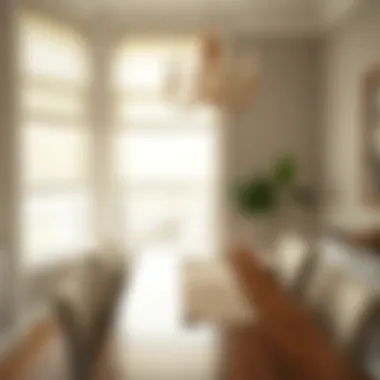
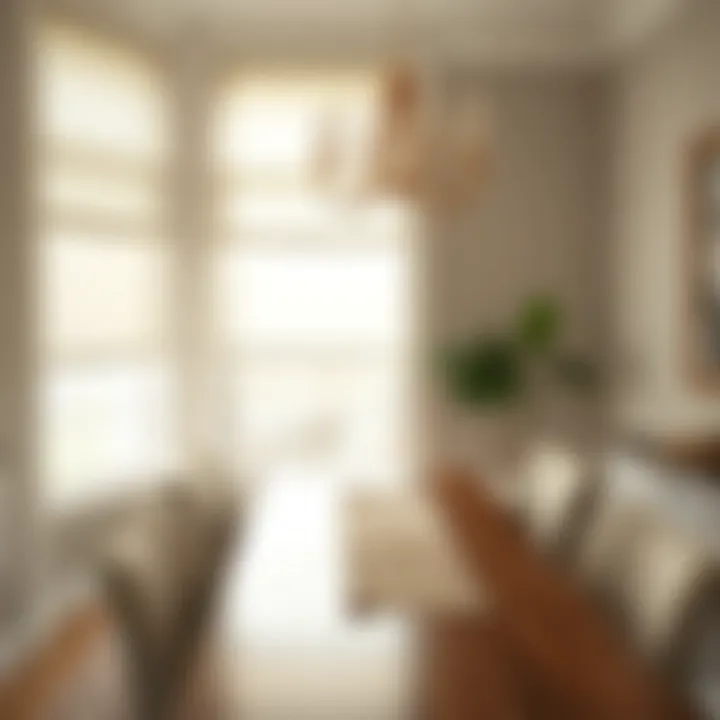
When it comes to measuring your windows for blinds, precision is key. An inaccurate measurement can lead to unsightly gaps or, worse, blinds that don’t fit at all. To avoid these headaches, follow these steps:
- Gather Your Tools: You'll need a tape measure, pencil, and paper for jotting down your dimensions.
- Decide on the Mounting Type: Decide whether you want an inside mount (blind sits inside the window frame) or an outside mount (blind covers the entire window). Each method serves its own purpose, influencing appearance and light control.
- Measure Width: For an inside mount, measure the width of the window opening in three spots: top, middle, and bottom. Take the smallest measurement and subtract about a quarter of an inch for a snug fit. For an outside mount, add a couple of inches to your width measurements; this will allow your blinds to block more light.
- Measure Height: Similarly, measure the height of the window opening in three spots: left, middle, and right. Again, take the smallest measurement for an inside mount, and for outside mount, add an extra couple of inches.
- Check for Squareness: To ensure that your blinds will hang straight, check if the window frame is square by measuring diagonally from corner to corner. If the measurements differ, your mount may need some adjustments.
By carefully noting these dimensions, you can avoid a slew of issues down the line, ensuring your blinds fit like a glove.
DIY Installation versus Professional Services
When it comes to installing your blinds, you’re faced with a choice: should you roll up your sleeves and do it yourself, or should you hand it over to the pros? Each option carries its own advantages and considerations:
- DIY Installation
- Cost-Effective: Handling the installation on your own saves money on labor costs. If your budget is tight, this can be a vital advantage.
- Personal Satisfaction: There’s something rewarding about completing a project independently. Completing the job can give that cozy feeling of accomplishment.
- Flexibility: You can tackle the project at your own pace without the pressure of scheduling a professional appointment.
However, there are potential pitfalls to consider:
- Time-Consuming: Depending on your skill level, the installation may take longer than expected.
- Risk of Mistakes: Inexperience might lead to errors that affect the performance of the blinds.
On the other side of the coin, hiring a professional offers these benefits:
- Expertise: Professionals bring years of experience to the table, often resulting in a flawless finish.
- Speed: They can complete the installation in a fraction of the time it might take a newbie.
- Warranty: Some services may offer guarantees for their work, providing peace of mind.
Yet, this choice may also present challenges:
- Higher Costs: You're paying for labor, which can significantly bump up your total expenses.
- Less Control: Relying on someone else means you might not have as much say in how the job gets done.
Ultimately, the decision spills down to your comfort level with tools and home projects, the complexity of your chosen blinds, and whether you can spare the time or budget for professional installation. Whichever route you take, a well-executed installation will stand as the foundation for enjoying your beautiful indoor blinds for years to come.
Cost Considerations
When it comes to purchasing indoor blinds, cost is more than just a number; it is an integral part of the decision-making process which requires careful thought. The types of blinds you choose can impact not only the look and functionality of your space but also your budget in the long haul. A solid understanding of cost considerations will help you navigate the myriad options out there.
The first step is determining your specific needs. Are you looking for something budget-friendly, or are aesthetics and durability your primary concerns? Each style and material comes with its own price tag. For instance, while faux wood blinds may offer a polished wood-like appearance and cost less than real wood, their durability and maintenance needs differ.
"Budgeting for blinds isn't just about the initial purchase; it's about the long-term investment you make in your home."
Budgeting for Indoor Blinds
Setting a budget for indoor blinds is crucial. There are a few factors to consider when drafting that budget:
- Window Size: Larger windows typically require more material. This means costs can add up, especially if you want something custom-made.
- Material Choices: Blinds come in a variety of materials, from vinyl to fabric to wood. Generally, wood is pricier than vinyl, but you might find high-quality fabrics also pushing the envelope.
- Customization: If you go for custom sizes, colors, or designs, be prepared for a higher price point. While these add uniqueness to your space, they can also strain your budget.
- Installation Costs: Do you plan to install them yourself or hire a professional? DIY might save you some pennies, but consider the value of your time and skill level.
To strike a balance, prioritize your key functionalities while being aware of the costs associated with add-ons. Write down a detailed list of your must-haves and nice-to-haves to keep expenses in check.
Comparing Prices Across Brands
Now that you have a clear budget in mind, it’s the perfect time to compare prices across brands. Not all manufacturers price their products the same way, and some might offer better quality for a similar price.
- Research Online: Websites like Home Depot or Lowe’s allow you to filter by price range, material, and brand, giving you a comparative view. You might stumble upon seasonal discounts or clearance sales.
- Read Reviews: These can be extremely helpful. They provide insight into the longevity and quality of the blinds. Some brands trust in their customer service, providing great post-purchase supports which may save you costs in repairs or replacements.
- Visit Local Showrooms: If possible, don't skip this step. Touching and operating the blinds in person can provide valuable context that pictures online can’t deliver. Plus, you can often find promotions available only in-store.
- Ask for Swatches: When comparing materials, requesting samples can give you a better idea of how each option looks and feels. This can lead to a more informed purchasing decision and possibly even save you from costly mistakes.
Trends in Indoor Blinds
Staying updated on trends in indoor blinds is essential for homeowners and designers alike. Not only do these trends shape the aesthetics of a space, but they often influence functional benefits that can enhance daily life. As the needs and preferences of consumers evolve, manufacturers respond by introducing innovative materials and technology. The trends currently shaping the indoor blinds market reflect a growing awareness of sustainability, technology integration, and personalization in home design. Let's explore two key aspects of this trend.
Eco-Friendly Options
In recent years, the push for environmentally conscious choices has infiltrated every aspect of home design, and blinds are no exception. Eco-friendly options have gained traction, providing solutions that respect the planet while adding style to your home. When choosing blinds made from sustainable materials, consider options like bamboo or recycled fabric. These choices not only reduce carbon footprints but also offer unique textures and patterns that elevate interior aesthetics.
Additionally, many brands are emphasizing energy efficiency, producing blinds that are designed to help regulate heat within the home. For instance, cellular shades can trap air, offering insulation that reduces energy costs in both summer and winter months. This aligns with the trend of creating sustainable homes and contributes to a more comfortable living environment.
"Opting for eco-friendly blinds is not just a trend; it's a commitment to creating a better future."
Lastly, seeking certifications, like those from the Forest Stewardship Council (FSC), can guarantee that the materials used are responsibly sourced. As a homeowner, it's about aligning your choices with your values, ensuring that your design decisions impact the world positively.
Smart Blinds Technology
Another trend emerging in the indoor blinds landscape is the integration of smart technology. These high-tech options are quickly gaining ground among tech-savvy homeowners who value convenience and efficiency. Smart blinds can be operated remotely via apps or voice commands—think of adjusting your blinds with just a simple verbal cue or with a touch on your smartphone, leaving you cool and collected without lifting a finger.
Moreover, these intelligent systems offer features such as automatic scheduling, which means your blinds can open or close depending on the time of day or even ambient conditions like lighting or temperature. This kind of technology not only enhances comfort but can also bolster energy savings by ensuring that your environment is tenable at all times. For instance, smart blinds can help keep heat out during the peak of summer, reducing the need for air conditioning.
On top of that, many of these systems now support home automation, integrating seamlessly with platforms like Google Home or Amazon Alexa. This connectivity elevates the indoor environment into a realm of modern convenience that many homeowners are coming to expect.
By embracing smart blinds technology, you not only improve functionality but also add a tech-forward flair to your living spaces. The merging of design and technology is paving the path for a new era in interior design.
In summary, keeping an eye on trends in indoor blinds is pivotal to making informed choices that combine aesthetics and functionality. Through eco-friendly materials and smart solutions, homeowners can create a unique and sustainable living space that reflects both personal style and contemporary living demands.
Epilogue
As we wrap up this comprehensive exploration into the world of indoor blinds, it becomes clear that selecting the right type is more than a mere decorative choice; it significantly impacts the comfort and functionality of your living space. Indoor blinds serve multiple purposes, from effectively controlling light and ensuring privacy to enhancing energy efficiency in your home.
Summarizing Key Insights on Indoor Blinds
Throughout the article, we highlighted various types of indoor blinds that suit different needs and preferences. For instance, roller blinds are often chosen for their sleek and minimalistic design, while cellular shades are appreciated for their insulation properties. Each type of blind, whether it be sheer or wooden, brings its own unique flair to a room, allowing homeowners and interior designers alike to express creativity and style.
- Light Control: It’s essential to consider how much natural light you want in each space. Blinds like blackout options are perfect for bedrooms, while sheer blinds work well in living areas.
- Privacy and Security: Certain materials and designs can better secure your personal space. Vertical blinds can be an excellent choice for large windows or sliding doors.
- Energy Efficiency: Opting for insulated blinds can keep energy bills in check by maintaining a steady indoor temperature throughout the year.
Final Thoughts on Choosing the Best Indoor Blinds
In navigating the selection process for indoor blinds, keep in mind the balance between function and aesthetic appeal. As with any interior design decision, the best choice will reflect individual taste while addressing practical requirements. If you're contemplating a purchase, consider the lifestyle of your household - families with young children may prioritize safety features, while those who work from home might want options that boost focus through effective light filtration.
Moreover, it can be beneficial to view samples in your home environment before making a commitment. The way natural light interacts with materials can drastically alter their appearance and effectiveness, making this an essential step in your decision-making process.


